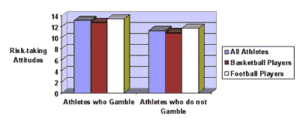Recent meta-analytic work suggests that the prevalence rate of lifetime pathological gambling is about 5.6% among college students (Shaffer & Hall, 2000). One segment of the college student population that has recently come under increased scrutiny is the student athlete. The WAGER reports on a study that suggested that student athletes who report that they gamble are more willing to take risks than those who do not report that they gamble (Cross, Basten, Hendrick, Kristofic, & Schaffer, 1998).
This study reported the results of a secondary analysis of survey data collected by Cullen & Latessa, (1996). Cullen and Latessa mailed a survey designed to assess National Collegiate Athletic Association (NCAA) rule-breaking to 2000 randomly selected male football and basketball NCAA Division I student-athletes. A total of 648 football players (51%) and basketball players (49%) participated. The survey measured risk-taking attitudes, gambling behaviors, and other rule-breaking behaviors. Attitude towards risk-taking was quantified by self-reported level of agreement with the following four statements: (1) I like to test myself every now and then by doing something a little risky, (2) Sometimes I will take a risk just for the fun of it, (3) I sometimes find it exciting to do things for which I might get into trouble, and (4) Excitement and adventure are more important to me than security. Researchers assessed gambling by the following two questions: (1) While you have been in college, have you gambled money on other college sporting events, and (2) While you have been in college, have you gambled money on a game in which you played? The WAGER reports results based on gambling question 1 because only 22 athletes reported that they gambled on games that they played in.
One out of every four (26%) student-athletes reported gambling on games in which they had not played. Cross et al. (1998) used the sum of the responses to the four risk-taking questions as the measure of attitude toward risk. Each question could be scored from 1 (strong disagreement) to 6 (strong agreement). Thus, the risk taking composite values could range from 4 to 24. Athletes who reported gambling on games other than their own had significantly higher risk scores than athletes who reported that they did not gamble.
Figure 1: Mean attitude toward risk-taking by gambling behavior.
The study showed that one-fourth of the student athletes gambled on sports. Gambling was related to a greater willingness to take risks. The authors should have provided information supporting the decision to create a composite risk-taking variable from the four risk-taking questions. It is unclear that the four items can be combined in a single scale that is more informative than examining each type of risk-taking behavior separately. More importantly, as with most self-report surveys, the honesty of the participants’ responses is a concern. This is particularly true for this study, because participants were answering rule-breaking questions that could potentially influence scholarships and future athletic participation. Although many athletes were willing to admit to gambling, the low response rates reported for this study may indicate student-athletes’ hesitancy to reveal this information. Another limitation is the ability of this study to generalize beyond the sample. The participants were all male and represented two sports. A more representative sample is needed to verify these findings. However, these limitations do not minimize the importance of the contribution Cross et al. make. Identifying high-risk populations is and will continue to be one of the most important issues for gambling research.
References
Cross, M. E., Basten, J., Hendrick, E. M., Kristofic, B., & Schaffer, E. J. (1998). Student-athletes and gambling: An analysis of attitudes towards risk-taking. Journal of Gambling Studies, 14(4), 431-439.
Cullen, F. T., & Latessa, E. J. (1996). The extent and sources of NCAA rule infractions: A national self-report study of student-athletes: A report to the National Collegiate Athletic Association.
Shaffer, H. J., & Hall, M. N. (2000). Updating and refining meta-analytic prevalence estimates of disordered gambling behavior in the United States and Canada. Boston, MA: Harvard Medical School.





